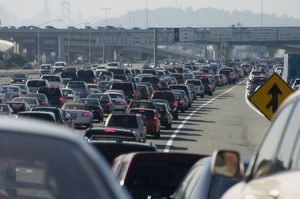
Proponents of Measure L have promised just about everything to everyone. Supposedly, it will be a boon to economic growth because it will enable the construction of expressways throughout Stanislaus County. Unfortunately, the biggest transportation barrier to economic growth is congestion on the Altamont Pass.
For over ten years, Caltrans has been working on widening the Interstate 580 Corridor. The work has been completed. Chronic congestion previously existed from Santa Rita Road in Pleasanton to the base of the Altamont Pass; now daily chronic congestion begins around North Livermore Avenue in Livermore to just east of the top of the Altamont Pass, where the freeway narrows from five lanes to four.
At some point, Alameda County may allow Interstate 580 to be widened all the way to the Interstate 205 interchange. If this happens, the current congestion could be mitigated. But….
The Endless Problem
Politically, in order to maintain its highway funding stream, Caltrans has a philosophy of adding freeway capacity in increments; Caltrans maintains a constant state of congestion somewhere in the system. Interstate 580 has been subject to widening between Oakland and the Central Valley since the 1960s.
By the time Interstate 580 has been widened all the way east to Interstate 205 from Oakland, the roadway will remain congested due to new residential development in the Central Valley. Measure L will build more expressways to take more commuters to the Altamont Pass. Stanislaus County does not generate new jobs locally as fast as it builds houses for new commuters. It thus serves as a bedroom community for the Bay Area.
The additional commuters from Valley counties will clog up Interstates 205 and 580, perpetuating the Altamont logjam. The Interstate 580 corridor is a major hindrance to Valley economic development because congestion hinders the movement of goods and workers. Because Measure L does not contribute one dime towards mitigation of Altamont Pass congestion, approval will exacerbate traffic problems to and from the Bay Area.
Fixing Freeway 99
Measure L proponents have promised to alleviate congestion on Freeway 99 by using money from the tax to help build more traffic lanes. Caltrans could fix Freeway 99’s problem by installing inexpensive metering lights at freeway onramps. Adding lanes is the most expensive fix for a problem that is only acute at rush hour.
The signal lights are easily funded from existing tax revenue. However, Caltrans and the Stanislaus Council of Governments prefer to let problems fester until desperate citizens vote themselves a tax increase.
Synchronized Signals
Synchronization of traffic signals is a very low cost way to mitigate traffic congestion. For about $100,000, Modesto can adjust signals throughout the city. Measure L voters are being asked to approve a tax increase that will generate nearly $1 billion dollars. Politicians are using the equivalent of extortion to get a project that should easily be funded via present tax revenues.
The first transportation dollar spent in any community should be to synchronize signals because they reduce congestion, reduce air pollution, and reduce incidents of road rage.
Traffic Circles
The cost to build a traffic circle (roundabout) at an intersection is about the same as the cost to install a traffic signal. Traffic circles reduce congestion because traffic moves constantly and smoothly through the intersection and reduces auto accidents by 90 percent versus signalized intersections.
Community leaders show no inclination to improve traffic conditions, preferring traditional inefficiency. When voters approve Measure L, they will agree to business as usual and reward mediocre traffic management.
State Route 132
Instead of building a freeway the length of the route from Modesto to Interstate 580, the plan is to build it in phases. The intent of using phases is to keep the route congested during the entire period from the completion of phase one to the final phase.
The way it works is a few miles of freeway is built during phase one. After completion of phase one, more motorists will use Route 132 to get to the Bay Area. Phase two will start only after the route becomes congested to the point where people are demanding action. The remaining phases will be built in a similar manner, resulting in up to two or more decades of congestion along the route. Passage of Measure L will enable this process to begin.
The False Promise
Advocates for Measure L promise that roads will be fixed and roadway congestion will be eliminated. Measure L does not enable the promise to be kept because the revenue it generates will be scattered in such a way that nothing will get done right. We can see this is so by the manner in which the road system is currently managed.
Signals aren’t synchronized even though sufficient funds exist to do so now. Roads are patched but aren’t really fixed. Congestion builds because inadequate developer infrastructure fees are assessed. Best practices are not employed for intersection configuration. And Measure L does not address the biggest barrier to economic growth: the congested Altamont Pass corridor.

An important mode of transportation was not mentioned, the ACE train. What part could it play if a larger % of Measure L dollars were allocated to it and less to the items of concern you mentioned?
The Ace train is heavily subsidized by taxpayers. Studies indicate insufficient demand for the service to justify the added cost. A BART extension to Stockton has also been discussed for years. It has not been built due to insufficient population along the proposed corridor.
Among Great Valley Commuters, public transportation is the least popular option.
California is working on a plan to raise money for transportation projects by taxing cars per mile driven. Drivers can also expect the establishment of more carpool lanes with congestion pricing.
a train has been needed for many years